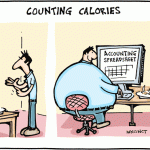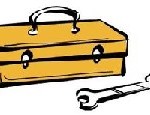

I don’t count calories anymore…but I used to.I consider calorie counting to be a type of mental food training – it’s a step in the process, but it’s definitely not the end goal.Put another way, calorie counting is how you gain control, but is not control in-and-of itself. Put another way, it’s one of the biggest steps in gaining control of your eating, but it is not the final step.By focusing solely on the act of calorie counting, and not the lessons learned from it, you never really learn what “too much” feels like, or perhaps more importantly you never learn what “Just right” or “not enough” feels like.You simply spend your life eating to an amount of calories that a calculator estimated you should be eating, and you do so by adding up all the estimated calorie contents of the foods you ate, based on estimated portion sizes… Not my ideal way to let go and be less obsessive about food.Instead of tracking my daily calories I now rely on the feelings of “not enough, just right and too much”. Combined with fasting once or twice a week this has served me incredibly well over the last half-decade.It’s tricky, but learning what ‘just right’ actually feels like is far more valuable than trying to excel spreadsheet your way to weight loss by working off of estimated calorie counts on estimated weights of foods that you track…And I know that the idea of eating by ‘feel’ is probably a little to wishy-washy for some people’s obsessive compulsive need to track EVERYTHING in their lives, but basically what I’m saying (or trying to say) is that once you get the hang of it going by ‘feel’ is probably no less accurate than calorie counting –since as I said before with calorie counting you are still counting other people’s guesses aiming for a calorie total that may or may not be right for you.I will say there are some caveats to this approach.Firstly, there are some foods that are ‘hyper-palatable’ that you need to be aware of – These are foods and drinks that are really high in calories, but they don’t make you feel as ‘full’ as you should – Regular soft drinks (non-diet) would be an example, as would some pastries/sweet baked goods and many fast foods (For a good book on hyper-palatable foods check out The End of Overeating).You can still eat these foods (I had an ice-cream filled donut sandwich over the weekend) you just have to be aware that the days you do eat these food are more than likely days you went ‘over’ even if you don’t have the normal feeling you’d associated with eating ‘too much’.The other caveat is that in order to get to the point where you can eat by feel you will probably have to spend a good amount of time calorie counting – in order to train yourself to know what each feeling represents.The bottom line is that calorie counting is an important part of the process but in my eyes becoming an expert in tracking your calories on a spreadsheet shouldn’t be the end goal of stress free weight maintenance – instead it should be a training tool to get you to the point where you can eat and manage your weight, based on feel.BPPS – This is also how I choose which days I’m going to fast, and why my book Eat Stop Eat is based on one OR two fasts per week… the “OR” really depends on ‘feel’…basically your feel of how much you’ve eaten during the week.Tagged as: calorie counting, counting calories
Original source –
Why I don't count calories, but you probably should | Brad Pilon's …


 For now classes are 6pm and 640pm at 2840 Wildwood st in the Boise Cloggers studio.
Book your class NOW!
click this ==>
For now classes are 6pm and 640pm at 2840 Wildwood st in the Boise Cloggers studio.
Book your class NOW!
click this ==>








